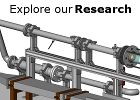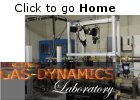Combustion Dynamics
Since the 90's, there have been increasingly stringent regulations on pollutants emitted out of gas turbines. These have led engine manufacturers to operate combustors with premixed fuel and air. This allows for temperature control of the combustion process and hence the concentration of emissions. One significant drawback of operation in the premixed mode though, is the dynamic behavior of these combustors.
Combustion dynamics includes the phenomenon of pressure oscillations in both, aircraft and land-based power generation engines. These lead to cracks and thermal hot-spots in different parts of the engine. Understanding and control of these oscillations are key to the reliable and robust operation of power-plants and propulsion systems.
The objectives of our efforts at MIT are to develop a fundamental understanding of combustion dynamics in cases when flames are stabilized by recirculating flows formed in the wake behind sudden expansions or in swirl stabilized flows. We are currently working with syngas at varying hydrogen &ndash carbon monoxide ratios, premixed with air over a range of equivalence ratios, inlet temperatures and Reynolds numbers. We are conducting experiments in both a planar combustor and a newly designed axisymmetric combustor. The insight gained from these experiments will be used to suggest different variations on the flame stabilizations environments aimed at passively stabilizing the flames.
Fuel Flexible Combustion
Syngas, a mixture of hydrogen and carbon monoxide produced by burning coal in pure oxygen and steam in high pressure gasifiers, has been proposed as the fuel of choice for modern high efficiency low emission combined cycles power plant, in which gas turbine engines are used as topping cycles that take advantage of high temperature combustion products to improve the overall efficiency of the power plant. Incorporating technologies to filter out turbine-corroding gases from the gasifier products and delivering clean syngas to the gas turbine combustor enables the use of syngas in gas turbines. Furthermore, efficient separation technologies can be used to produce hydrogen from the syngas, which can then be fed into fuel cells to further improve the energy conversion efficiency of the plant. The sequestration of carbon dioxide, following the production of steam for the bottoming cycle, makes this plant environmentally ideal.
Dynamic Response of Premixed Flames
Perforated-plate stabilized premixed flames are used extensively in industrial and compact household burners. In these systems, the coupling between the acoustics and the unsteady heat release rate often leads to self-excited oscillations, which in extreme cases may result in fatal structural damage. The dynamic response of the flame to the velocity perturbations in the system determines the nature of the combustion instability, and has thus received significant attention in the recent years. This response is typically characterized by the flame transfer function (FTF). From experimental investigtations by many researchers, it has been well established that at certain low frequencies, the heat release amplitude (non-dimensionalized by the mean) is greater than the non-dimensional amplitude of the imposed velocity oscillations. We are investigating the physical mechanisms behind such resonance like behavior of the system.
In our recent work, we have shown that the dynamic response of a premixed flame stabilized on a heat-conducting perforated plate depends critically on their coupled thermal interaction. We are investigating this problem using detailed numerical simulations with thermal coupling between the heat-conducting solid burner and the fluid domain. We are also developing simplified analytical models to predict the dynamic response of the flames.
Instability Mitgation
Dynamic instabilities are the main roadblock to developing low-emission, lean-premixed combustors for power generation and aviation applications. Instabilities arise from a positive coupling of the flow dynamics and the premixed flame response. In combustors with swirling geometries, vortex breakdown, vortex shedding, and precessing vortex cores contribute to the periodic coherent structure-flame interactions that govern the dynamics.
Our work has shown that dynamic instability in a swirl-stabilized combustor is more strongly correlated with inlet vortex profile than previously thought. Under certain conditions, the modification of the vortex structure itself is sufficient to alter the dynamics and mitigate dynamic instabilities.
Current research in this area is focusing on decomposing the flame response into fundamental modes, and examining how those modes evolve with the change of combustion parameters, primarily flame speed and flame temperature.







